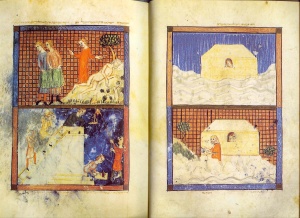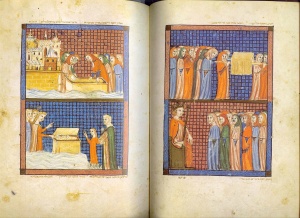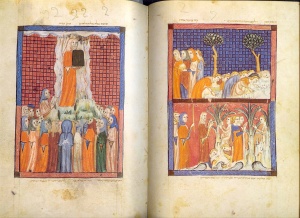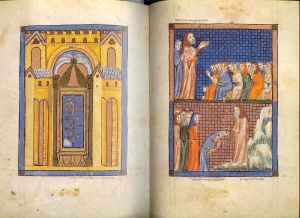The Sarajevo Haggadah: The Choice of Images
All Jewish Art depends upon the choice of subject as the primary vehicle to elicit meaning. Style, composition, form and innovation operate in the context of the theme drawn from Jewish texts, commentaries, midrashim and history. For the artist that initial choice inevitably influences the artistic agenda of what follows. In the Sarajevo Haggadah, one of the most treasured masterpieces of the Jewish people, the artist’s choice of biblical passages molded the intellectual shape and tone of this fourteenth century Catalonian masterpiece.
The Sarajevo Haggadah was created in Barcelona, circa 1350, for a prominent Jewish family. Their connection with the rulers of the Kingdom of Aragon is evidenced by the heraldic crests found on the title page. It is likely that the haggadah left Spain during the Expulsion of 1492. From marginal notations we know it was sold in northern Italy in August 1510 and then examined by an Italian ecclesiastical censor in 1609. Subsequently it was brought to Sarajevo, Bosnia where the Jozef Kohen family sold it in 1894. Housed in the Bosnian National Museum, its fame attracted the interest of the Nazi invaders in 1941 which resulted in its being hidden in neighboring villages until after the war.
During in the Bosnian War (1992-1995), just days before the National Gallery was bombed, it was once again removed and hidden. In December 2002 the first permanent public display of the newly restored haggadah inaugurated the National Museum of Bosnia as a symbol of the hope for peace and democracy in the new nation of Bosnia-Herzegovina.
The fame of this haggadah arises from its great age, beauty and sheer quantity of textual decorations and illuminated miniatures. The handwritten manuscript, written on vellum (calf skin similar to klaf used for a sefer Torah), begins with thirty-four pages of miniature paintings. They are painted on one side of the vellum to prevent any bleeding from one side to the other. On these pages there are a total of sixty-eight panel paintings that depict the biblical narrative from the creation of the world through the death of Moses. The story of Joseph is given special attention in seventeen panels.
After this breathtaking introduction the main text of the haggadah is written in a bold Sephardic script on both sides of the next fifty pages. The text is a wonder of decoration and embellishment displaying more than fifty ornamented and gilt word panels, assorted grotesques and floral decorations. Four additional miniatures depicting Rabban Gamaliel, Matzah, Maror and a Spanish Jewish family at the Seder enhance this section. The remaining fifty-eight pages are relatively unadorned piyyutim, biblical readings and prayers for the holiday.
According to the venerable Jewish historian, Cecil Roth, “it would seem probable that the illuminator of the Sarajevo Haggadah was a Jew.” because of his “cognizance and sympathy for the text.” Other details such as the tendency of individual panels to narrate from right to left (Lot flees leftward and Abraham walks left towards the Akeidah) echo Hebrew reading and point to a Jewish artist. The sophisticated integration of midrashic and biblical material and local Jewish costumes of the time (hooded gowns characteristic of Barcelonian Jewry) reinforce this view.

The miniature cycle is fascinating on a number of levels. The sheer multiplicity of images allows the artist to develop sub-narratives. They are played out on opposing pages as the codex is laid open. The shape of the ark is repeated in Noah in the Ark and Noah offering a thanksgiving sacrifice. This is contrasted with the strong diagonals in the scene of the drunken Noah and the builders of the Tower of Babel found on the opposite page. The theme of the righteous and dutiful man following God’s instructions is sullied by his foolish abuse of wine and mankind’s vanity in the Tower’s construction. The artist has composed the entire four panel suite to nurture a new perspective on the text. The steady pattern of alternating blue and sienna red backgrounds framed in blue borders is repeated throughout.

In section after section the sub-motifs proliferate into a running commentary by the artist. Rebecca gives birth to Jacob and Esau while simultaneously we see the brothers as an adult hunter and Torah scholar. Below, the stolen blessing is engineered by Rebecca and is then followed on the opposite page by Esau’s heartfelt plea to Isaac for his blessing. That page finishes with the revelation of Jacob’s dream. This set provides a stark examination of Isaac’s actions as a father, Rebecca’s manipulations and the contrasting qualities and merits of each of their sons. In the context of a mere four panels a concise and complex family history that much of humanity shares is explicated.
Ultimately, it is the extraordinary emphasis on the Joseph story that establishes the fundamental perspective of the illuminations. Similar to other Catalonian haggadahs such as the Golden Haggadah in the British Library, the story of Joseph is predominant, occupying over twenty-five percent of the miniature panels. These seventeen illuminations detail his dreams, conflicts, sale, trials, role as ruler of Egypt and final reconciliation with his brothers and father. As the procession to bury Jacob is paired with the burial of Joseph, the last set illustrates the midrash of a Joseph’s coffin that was sunk in the Nile. The Nile / Aron motif is continued with the finding of the aron with the infant Moses by Pharaoh’s daughter. The death of the patriarch Jacob in proximity with the death of the righteous Joseph and the birth of the man who will lead the Jews out of bondage creates a pictorial equation that demands us to believe in redemption even when all seems lost.
The fluid and sometimes dangerous political situation for the Jews in mid-fourteenth century Spain demanded political acuity on the part of the Jews in positions of power, much like the savvy Joseph. However such a practical program was not always sufficient. When all was said and done, a broader perspective for communal survival was necessary. The artist reveals this in the last three sets of facing pages.

Dominated by full page illuminations these passages have a powerful effect on the reader. The collection of the heavenly manna and the sustenance of the wells at Elim are facing the image of Moses in the midst of the fire, smoke and shofar blasts while receiving the Torah on Har Sinai. Torah seems to climax with the foregoing narrative. Yet the next set of miniatures depict the teaching of the Torah to the people and the transmission of Torah leadership to Joshua ben Nun. This pair is facing the full page image of “The Holy Temple which will be built soon, in our days.” The splendid medieval edifice allows us to see inside and glimpse the wings of the cherubim guarding the Holy Ark.

In the next and final set of illuminations the artist brings us back to the present with the serving of haroseth and matzot to guests assembled for a Sephardi Seder. A simple depiction of the synagogue interior, ark doors open to reveal three Torahs, climaxes the pictorial program. The congregation is leaving, families fortified by the blessings of a Torah community, ready to face the vicissitudes of life in an unredeemed world.
The artist has established his theme. The Law revealed at Sinai will lead, through daily practice in the synagogue community, to the redemption of the Jewish people and the restoration of the Third Temple. That is the final message the artist embedded in the Sarajevo Haggadah by his critical choice of subjects for illumination. We are the benefactors of his splendid choices.
The Sarajevo Haggadah Facsimile edition, printed in Bosnia, 1983, commentary text by Eugen Werber
Available at Joy Schonberg Galleries; 255 West 88th Street, New York, NY